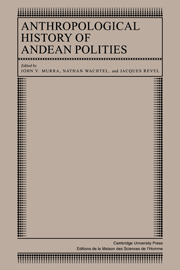Book contents
- Frontmatter
- Contents
- List of contributors
- Preface
- Introduction
- Part I Ecology and society
- 1 The tropical Andes: a changing mosaic
- 2 The evolution of a valley: population and resources of Tarapacá over a millennium
- 3 “Horizons” in Andean archaeology
- Part II The ethnic group and the state
- Part III Systems of classification
- Part IV Symbolic representations and practices
- Part V From ethnic polities to communities
- Bibliography of published source
- Index
2 - The evolution of a valley: population and resources of Tarapacá over a millennium
Published online by Cambridge University Press: 05 October 2010
- Frontmatter
- Contents
- List of contributors
- Preface
- Introduction
- Part I Ecology and society
- 1 The tropical Andes: a changing mosaic
- 2 The evolution of a valley: population and resources of Tarapacá over a millennium
- 3 “Horizons” in Andean archaeology
- Part II The ethnic group and the state
- Part III Systems of classification
- Part IV Symbolic representations and practices
- Part V From ethnic polities to communities
- Bibliography of published source
- Index
Summary
The Tarapacá Valley lies in a dip at the edge of the plain that descends from the Andes to form the pampa of Tamarugal, part of the arid lands of northern Chile. During the more recent part of the Quaternary, the valley was subject to turbulent flows that lasted to the end of the Pleistocene. In a later period, the rains at the continental divide caused intermittent floods varying in strength according to rainfall in the Andes. The Tarapacá River allowed the formation of oases throughout this vast and extremely arid region. After the Pleistocene, there apparently was an increase in summer rainfall on the Andean peaks, creating an intense hydrological cycle in the lower valley. During the hot season this cycle was activated by floodwaters that reached as far as the pampa of Iluga (Tricart 1965). By summer's end the torrents brought back the vegetation both to the floor of the valley and to the surrounding pampas. A brush forest cover would expand and contract according to the extent of the waters. Groundwater saturating the slopes would surface in numerous springs; it also maintained large groves of prosopis, growing near the temporary lakes and swamps. All this could be found in a place where the valley had to yield to a landscape that is today one of the most arid in the world.
Hunter-gatherers
The earliest hydrological model to involve people apparently functioned from 8000 to 2000 B.C. It did manifest fluctuations, with threatening droughts (though apparently not as long as those of today) but also wet periods, with frequent floods.
- Type
- Chapter
- Information
- Anthropological History of Andean Polities , pp. 23 - 34Publisher: Cambridge University PressPrint publication year: 1986
- 3
- Cited by



